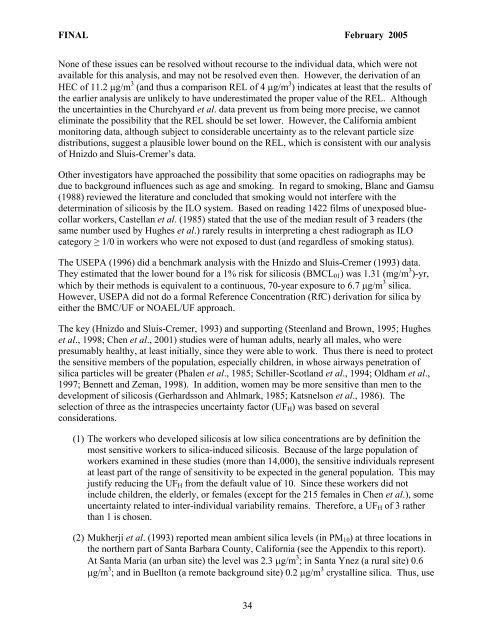Silica (crystalline, respirable) - OEHHA
Silica (crystalline, respirable) - OEHHA
Silica (crystalline, respirable) - OEHHA
Create successful ePaper yourself
Turn your PDF publications into a flip-book with our unique Google optimized e-Paper software.
FINAL February 2005<br />
None of these issues can be resolved without recourse to the individual data, which were not<br />
available for this analysis, and may not be resolved even then. However, the derivation of an<br />
HEC of 11.2 µg/m 3 (and thus a comparison REL of 4 µg/m 3 ) indicates at least that the results of<br />
the earlier analysis are unlikely to have underestimated the proper value of the REL. Although<br />
the uncertainties in the Churchyard et al. data prevent us from being more precise, we cannot<br />
eliminate the possibility that the REL should be set lower. However, the California ambient<br />
monitoring data, although subject to considerable uncertainty as to the relevant particle size<br />
distributions, suggest a plausible lower bound on the REL, which is consistent with our analysis<br />
of Hnizdo and Sluis-Cremer’s data.<br />
Other investigators have approached the possibility that some opacities on radiographs may be<br />
due to background influences such as age and smoking. In regard to smoking, Blanc and Gamsu<br />
(1988) reviewed the literature and concluded that smoking would not interfere with the<br />
determination of silicosis by the ILO system. Based on reading 1422 films of unexposed bluecollar<br />
workers, Castellan et al. (1985) stated that the use of the median result of 3 readers (the<br />
same number used by Hughes et al.) rarely results in interpreting a chest radiograph as ILO<br />
category ≥ 1/0 in workers who were not exposed to dust (and regardless of smoking status).<br />
The USEPA (1996) did a benchmark analysis with the Hnizdo and Sluis-Cremer (1993) data.<br />
They estimated that the lower bound for a 1% risk for silicosis (BMCL01) was 1.31 (mg/m 3 )-yr,<br />
which by their methods is equivalent to a continuous, 70-year exposure to 6.7 µg/m 3 silica.<br />
However, USEPA did not do a formal Reference Concentration (RfC) derivation for silica by<br />
either the BMC/UF or NOAEL/UF approach.<br />
The key (Hnizdo and Sluis-Cremer, 1993) and supporting (Steenland and Brown, 1995; Hughes<br />
et al., 1998; Chen et al., 2001) studies were of human adults, nearly all males, who were<br />
presumably healthy, at least initially, since they were able to work. Thus there is need to protect<br />
the sensitive members of the population, especially children, in whose airways penetration of<br />
silica particles will be greater (Phalen et al., 1985; Schiller-Scotland et al., 1994; Oldham et al.,<br />
1997; Bennett and Zeman, 1998). In addition, women may be more sensitive than men to the<br />
development of silicosis (Gerhardsson and Ahlmark, 1985; Katsnelson et al., 1986). The<br />
selection of three as the intraspecies uncertainty factor (UFH) was based on several<br />
considerations.<br />
(1) The workers who developed silicosis at low silica concentrations are by definition the<br />
most sensitive workers to silica-induced silicosis. Because of the large population of<br />
workers examined in these studies (more than 14,000), the sensitive individuals represent<br />
at least part of the range of sensitivity to be expected in the general population. This may<br />
justify reducing the UFH from the default value of 10. Since these workers did not<br />
include children, the elderly, or females (except for the 215 females in Chen et al.), some<br />
uncertainty related to inter-individual variability remains. Therefore, a UFH of 3 rather<br />
than 1 is chosen.<br />
(2) Mukherji et al. (1993) reported mean ambient silica levels (in PM10) at three locations in<br />
the northern part of Santa Barbara County, California (see the Appendix to this report).<br />
At Santa Maria (an urban site) the level was 2.3 µg/m 3 ; in Santa Ynez (a rural site) 0.6<br />
µg/m 3 ; and in Buellton (a remote background site) 0.2 µg/m 3 <strong>crystalline</strong> silica. Thus, use<br />
34















